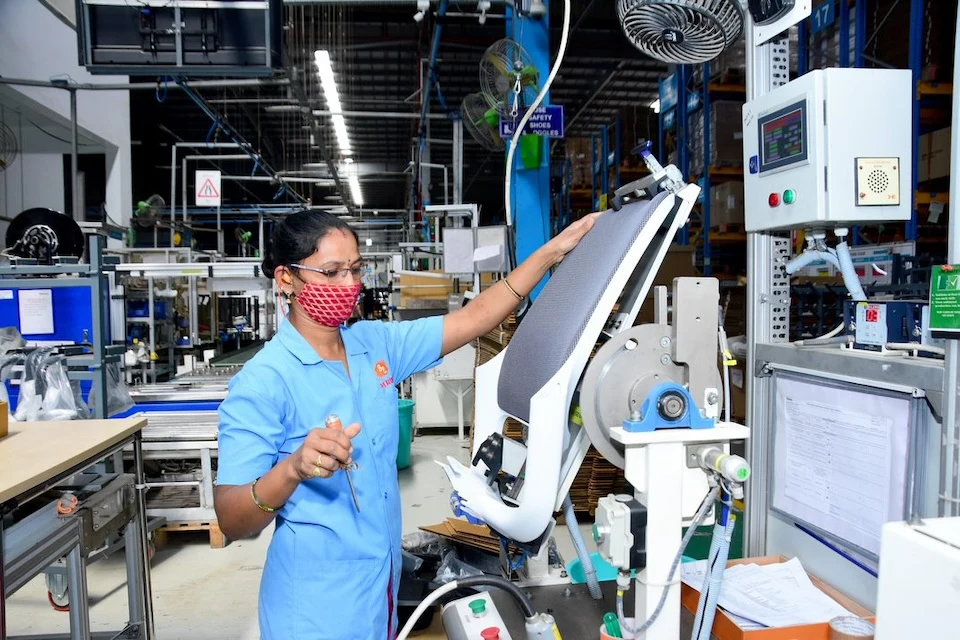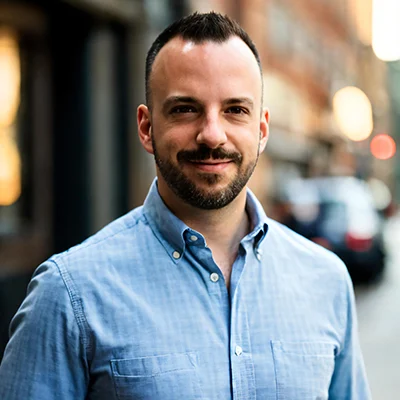& Construction

Integrated BIM tools, including Revit, AutoCAD, and Civil 3D
& Manufacturing

Professional CAD/CAM tools built on Inventor and AutoCAD
Steelcase, a global design and thought leader in the world of work, creates and manufactures furniture for offices, hospitals, and classrooms. The company works to build diverse teams, ensure equitable access to opportunity, and create a culture of inclusion. Developing a sustainable, diverse global workforce is as important to the organization as developing better workplaces. “To make a transformational difference, we need to operate in new ways by establishing more inclusive and innovative approaches,” says Kim Dabbs, global vice president of ESG and social innovation at Steelcase, which is based in Grand Rapids, MI.
Steelcase isn’t alone. Among companies in the Design and Make industries, 43% say skilled talent is a barrier to growth, according to Autodesk’s 2024 State of Design & Make report. That’s down significantly from 64% in 2023. Although macroeconomic conditions may explain some of the drop, the report reveals that expanded recruitment and upskilling efforts have been among the top solutions companies have turned to in addressing the talent problem. These approaches can help them attract new employees, retain existing ones, and improve productivity to the mutual benefit of employer and employee.
In addition, the State of Design & Make report states that businesses are taking steps to strengthen their company cultures to appeal to recruits and convince workers to stay for longer. Leaders at Steelcase spend a great deal of time thinking about how to build a more diverse and inclusive workplace culture. “The work experience is shaped by policies, process, and tools, but it’s also shaped by culture and space,” Dabbs says. “We’re focused on creating a culture of inclusion and belonging where everyone feels seen, heard, and valued. The workplace is part of that experience. We’ve been growing our inclusive design practice and learning alongside global partners to create more accessible and equitable spaces for people to work.”
Although the global talent picture is improving, challenges for many organizations persist, including lack of access to skilled employees, a rapidly aging workforce, and high rates of attrition. Four impact-driven programs that illustrate Steelcase’s approach to talent could hold the key to overcoming them.
—Kim Dabbs, Global Vice President of ESG and Social Innovation, Steelcase
Workforce development isn’t just about hiring individual workers today. At Steelcase, it’s about developing new talent in a way that strengthens entire communities. That’s why the company has a longtime partnership with the West Michigan Center for Arts and Technology (WMCAT), a nonprofit that helps both youth and adults generate social and economic opportunities by way of finding and pursuing rewarding career paths.
Specifically, WMCAT offers hands-on arts and technology programming for middle school and high school students to help them learn by doing; a gap-year program for recent high school graduates to help them find direction and choose a career path; and an adult workforce development program to help unemployed adults transition back into school, complete externships, and prepare for living-wage careers.
For Steelcase, supporting WMCAT and organizations like it is a chance to invest in future workers—while simultaneously helping current workers address gaps in education and employment opportunities that can help strengthen the communities in which they reside. “We take a look at not just upskilling and reskilling little by little, but reimagining what those ecosystems are and what nontraditional help pathways and pipelines look like,” says Dabbs, who previously served as WMCAT’s leader.
What makes its partnership with WMCAT so successful, Steelcase suggests, is that it isn’t just donating time or money to a cause; it’s using its subject-matter expertise to collaborate on meaningful solutions to real problems. In fact, that’s how it measures performance, according to Dabbs, who says Steelcase puts partners like WMCAT in the driver’s seat by allowing them to set goals and define success.
"We use impact models,” Dabbs says. “It’s not just the number of kids in the program. We ask: ‘How are their lives actually improving?’ We work with community partners that are closest to the issues to be able to define what impact looks like for them in their community.”
In Cluj, Romania, Steelcase’s Camp Ignite aims to empower youth to become economically prosperous and socially responsible adults. Established in 2015 in partnership with the child-focused nonprofit World Vision, the five-day retreat takes place twice a year. There, Steelcase employees design and facilitate workshops, group sessions, and team-building activities for 30 teens from underrepresented Romanian communities. Subjects include leadership, critical thinking, gender equity, diversity, and inclusion.
“It’s so beautiful,” says Dabbs, who explains that Camp Ignite’s mission is challenging gender stereotypes by offering leadership training to “help girls find their voices” and to “teach boys how to empower women.”
For some camp graduates, the experience that starts at Camp Ignite eventually continues in the form of Ignite Explorers, a three-week internship for Camp Ignite alumni at Steelcase’s offices in Cluj. “We’re taking former campers and exposing them to multiple career pathways,” says Dabbs, who notes that Ignite Explorers is an opportunity to build on the lessons learned at Camp Ignite in ways that prepare young people for future careers. “It’s not about reskilling or upskilling in the traditional way, because we’ve been a part of their lives. We’ve helped them find their voice in ways that can unleash their gifts.”
In 2022, Steelcase created yet another chapter in the Camp Ignite progression: Ignite Amplify, which pairs Explorer graduates with Steelcase mentors for three months of professional development that creates growth opportunities for mentors and mentees alike.
As in many other countries, women in India have not traditionally worked in the manufacturing sector. At a Steelcase plant in the bustling city of Pune, however, a group of mighty women who call themselves the Women of Steel see things differently. To them, factory jobs are invaluable stepping stones to social and economic freedom.
Steelcase supports the Women of Steel by embracing three “A’s” that are intended to facilitate change in a country that still clings to many outdated gender stereotypes:
Attitude: Steelcase seeks to educate managers and community members about the reality of modern manufacturing so they can more easily visualize women succeeding on the factory floor. Recruiting male allies who can advocate for women in the workplace is particularly important.
Accommodations: To help women more easily transition into the workforce, plant leaders in Pune offer flexibility, education, and training, including benefits such as job sharing, childcare, and transportation.
Action: Steelcase has created space for women to succeed in Pune by building an assembly line that’s staffed exclusively by women. Another all-women line is in the works, and plant leaders are committed to hiring women for other roles and to working with vendors who similarly engage women workers.
To not only grow the size of their workforce but also remove barriers to opportunity, companies are beginning to tap new and previously overlooked talent pools from which they can recruit individuals who bring valuable skills and fresh perspectives. For Steelcase, one of those talent pools is migrants.
Since 2018, Steelcase has been working with migrant communities to create employment opportunities that are transformative both for immigrants and for the company. At its Grand Rapids location, for example, the human resources lead reached out to a local refugee organization seeking job applicants. Now, the company reports that approximately 45% of the employees at its Grand Rapids factories are underrepresented racial and ethnic minorities, including migrants. And at its distribution center in nearby Kentwood, MI, Burmese immigrants constitute nearly 20% of the company’s workforce.
In 2020, Steelcase expanded its migrant outreach to Europe by partnering with Ashoka, a global network of social entrepreneurs whose Hello Europe initiative is dedicated to finding and scaling successful solutions to migration challenges across the continent. In February 2023, for example, Ashoka and Steelcase convened a group of corporate leaders, social entrepreneurs, and migrant talent for a workshop focused on brainstorming new approaches to diversity, equity, and inclusion, including attracting, hiring, and onboarding a more diverse talent pool. The goal isn’t just hiring workers—it’s creating a roadmap that helps catalyze systemic change and social impact.
From Michigan to Europe, external partners have been critical in helping Steelcase create jobs, training, and onboarding that are legally and culturally tailored to migrant communities. “When we think about our community partnerships, we’re not just staying insular,” Dabbs says. “The best place to learn is from the communities that are closest to the issues.”
To the untrained eye, investments in building community connections and a positive workplace culture often look like little more than PR and marketing. At Steelcase, however, leaders see the bigger picture as they develop programs around the globe to identify skills gaps, find opportunities for training, and establish nontraditional recruiting pipelines.
“At the end of the day, if you can see not just your function or your organization, but the entire ecosystem that you’re a part of—how it’s all connected inside your industry and outside your industry—that’s where you’re going to see the best momentum,” says Dabbs, noting that organizations that have invested early in building a diverse talent pipeline and an inclusive workforce will be best positioned going forward “to deliver the needs and requirements of all their customers.”
Matt Alderton is a Chicago-based freelance writer specializing in business, design, food, travel, and technology. A graduate of Northwestern University's Medill School of Journalism, his past subjects have included everything from Beanie Babies and mega bridges to robots and chicken sandwiches. He may be reached via his website, MattAlderton.com.
Executive insights
PD&M
Executive insights







